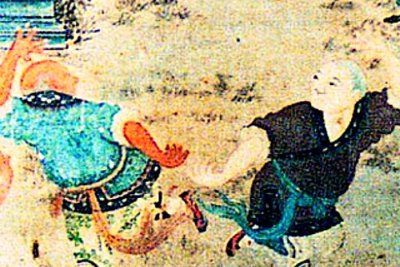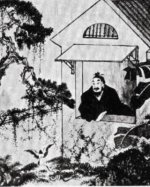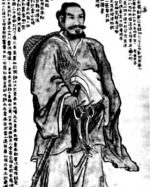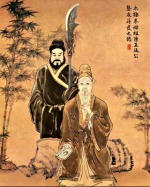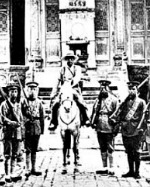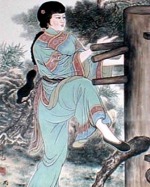The History of Kung Fu
What is Kung Fu?
Kung fu is not one system of fighting but rather a term that has come to be translated as Chinese martial arts.
It encompasses many forms of combat including external and internal styles and has roots in the country that can be traced back at least 1,500 years.
Talk the Talk
The term Shaolin is often translated as meaning young/new forest, as taught by twentieth-century tai chi master Chang Dsu Yao.
However, this translation has been deemed incorrect by scholars, who now state Shao refers to Mount Shaoshi where the original temple was built (though lin does
mean forest).
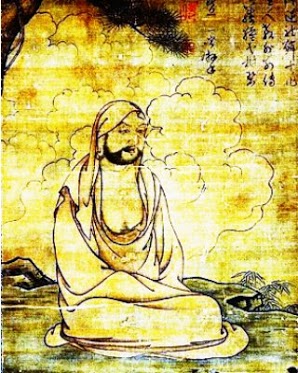
Kung fu (also known as gong fu) is, contrary to popular belief, not a martial art in of itself but has come to mean Chinese Martial Arts in Western societies. The correct meaning however is any skill that is learned through hard work and practice, or more literally it can be said to mean human achievement.
That said the term kung fu is easily recognisable and is therefore a useful umbrella term for the Westerner used to describe the various fighting systems to come out of China, especially those that derive from the Shaolin Temples.
The term first appeared in the West in its modern context in the eighteenth century when it was used by the French missionary Jean Joseph Marie Amiot. However, it did not become a widely used phrase until the 1960s, when it was popularized by Bruce Lee and his kung fu films; prior to this, the term Chinese boxing was a more common way to describe martial arts from the country.
Tracing the History of Kung Fu
As is the case with many world martial arts, tracing the history of kung fu is difficult as for many years, people outside of the military were forbidden to learn it on pain of death. As a result, much of the teachings were never written down and a considerable amount of what was recorded has been lost or destroyed over the centuries.
The importance of the teachings of the Shaolin monks in the Henan Province cannot be overstated as it was here that anything resembling modern Chinese martial arts was started. It is claimed that a fighting system was developed there as a direct result of the teachings of an Indian Buddhist monk called Bodhidharma (depicted above), who taught the monks there a set of Yogic movements to help improve their general fitness and well-being.
Over the years, different systems emerged from various parts of the county that have resulted in a rich tapestry of styles that developed in different ways depending on the needs of the people in a particular time and place. Different philosophies, weapons and movements are utilized but all can be said to be kung fu; be it in the Western or the literal Chinese interpretation of the words as all are disciplines that demand constant practice over a lifetime if one has any hope of becoming a master.
Written by Andrew Griffiths – Last updated 17/07/2023. If you like
what you see, consider following the History of Fighting on social media.
Find Us On:



Further Reading:
About Kung Fu. [Internet]. 2013. Case Western Reserve University. Available from: http://filer.case.edu/org/casekungfu/kungfu.html [Accessed March 1, 2013].Kung Fu (Term). [Internet]. 2013. Princeton University. Available from: http://www.princeton.edu/~achaney/tmve/wiki100k/docs/Kung_fu_%28term%29.html [Accessed March 1, 2013].
Shaolin History. [Internet]. 2008. Shaolin Gung Fu Institute. Available from: http://www.shaolin.com/historycontent.aspx [Accessed March 1, 2013].
More Kung Fu History
Bodhidharma
Bodhidharma (Ta Mo in Chinese) was an Indian Buddhist monk who is believed to have travelled to China in the sixth century. So the legend goes, while there he visited the Shaolin Monastery and taught the monks there a set of yogic exercises to improve their overall health. Over time, these exercises would evolve into martial arts, or more specifically, into Shaolin kung fu.
Bodhidharma (Ta Mo in Chinese) was an Indian Buddhist monk who is believed to have travelled to China in the sixth century. So the legend goes, while there he visited the Shaolin Monastery and taught the monks there a set of yogic exercises to improve their overall health. Over time, these exercises would evolve into martial arts, or more specifically, into Shaolin kung fu.
The Early History of Shaolin Kung Fu
A look at how the the history of Shaolin Kung Fu expanded and grew between 527 and 1644. It is believed that many styles of Chinese martial arts have their origins in this period, which also saw the spread of the teachings of the Shaolin monks to temples in other regions.
A look at how the the history of Shaolin Kung Fu expanded and grew between 527 and 1644. It is believed that many styles of Chinese martial arts have their origins in this period, which also saw the spread of the teachings of the Shaolin monks to temples in other regions.
Zhang Sanfeng
Zhang Sanfeng who, according to legend, was the founder of an internal Chinese martial art known as Mien Chuen that would evolve into Tai Chi Chuan. After spending many years training in the Shaolin Temple, he made his way to the Wu Tang Mountains where he developed his new style after watching a fight between a snake and a crane.
Zhang Sanfeng who, according to legend, was the founder of an internal Chinese martial art known as Mien Chuen that would evolve into Tai Chi Chuan. After spending many years training in the Shaolin Temple, he made his way to the Wu Tang Mountains where he developed his new style after watching a fight between a snake and a crane.
The History of Tai Chi Chuan
Tai Chi utilises internal energy, known as Chi, along with physical movements, breathing techniques and meditations. It can be practiced as a martial art or purely for the health benefits it promotes, which include strength, balance, agility, flexibility and stamina along with improved concentration, relaxation and lowered stress levels.
The Shaolin in the Modern Era
The history of the Shaolin in the modern era has not been an easy one. The practice of Chinese martial arts was banned for much of the period and the monks considered enemies of the state because of their political ideologies and later their religious beliefs.
The history of the Shaolin in the modern era has not been an easy one. The practice of Chinese martial arts was banned for much of the period and the monks considered enemies of the state because of their political ideologies and later their religious beliefs.
Pak Mei – A Kung Fu Legend
Pak Mei was one of the famous Five Elders of Shaolin kung fu who developed the fighting system that would take his name. The system is a lethal combination of fighting techniques that combine the explosive power of the tiger with the dynamic speed of the leopard.
Pak Mei was one of the famous Five Elders of Shaolin kung fu who developed the fighting system that would take his name. The system is a lethal combination of fighting techniques that combine the explosive power of the tiger with the dynamic speed of the leopard.
Wing Chun Kung Fu
According to legend, after the burning of the Shaolin Temple in the 17th century one of the surviving Five Elders, Ng Mui, taught kung fu to a woman called Yim Ving Tsun. From this union, Ving Tsun (Wing Chun) kung fu was developed and passed down from one generation to the next.
According to legend, after the burning of the Shaolin Temple in the 17th century one of the surviving Five Elders, Ng Mui, taught kung fu to a woman called Yim Ving Tsun. From this union, Ving Tsun (Wing Chun) kung fu was developed and passed down from one generation to the next.
The images on this site are believed to be in the public domain, however, if any mistakes have been made and your copyright or intellectual rights have been breeched, please contact andrew@articlesonhistory.com.

